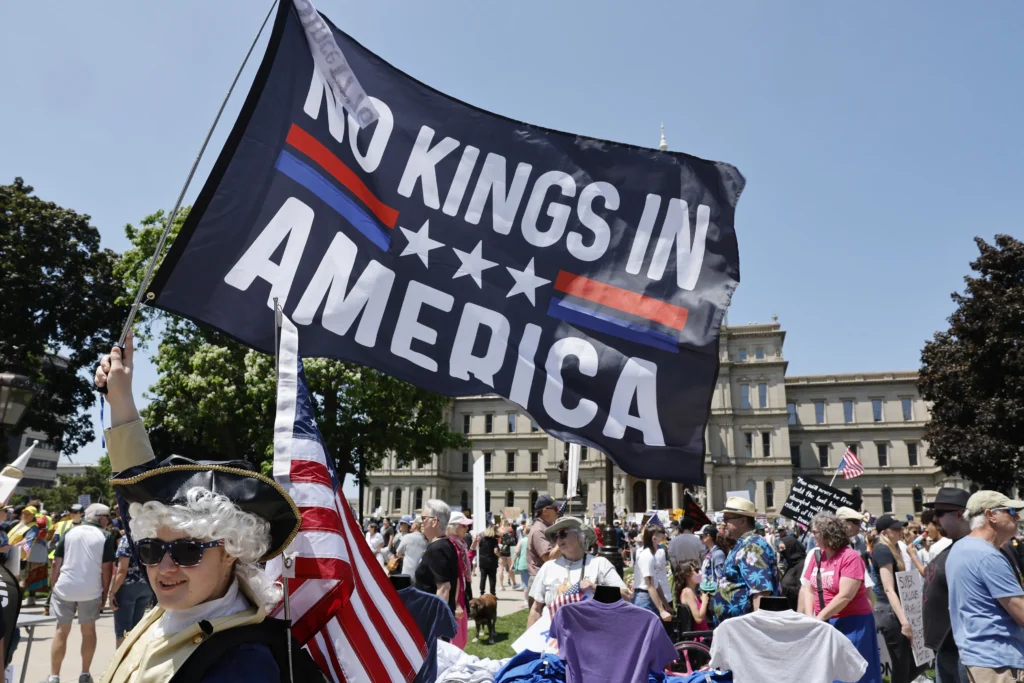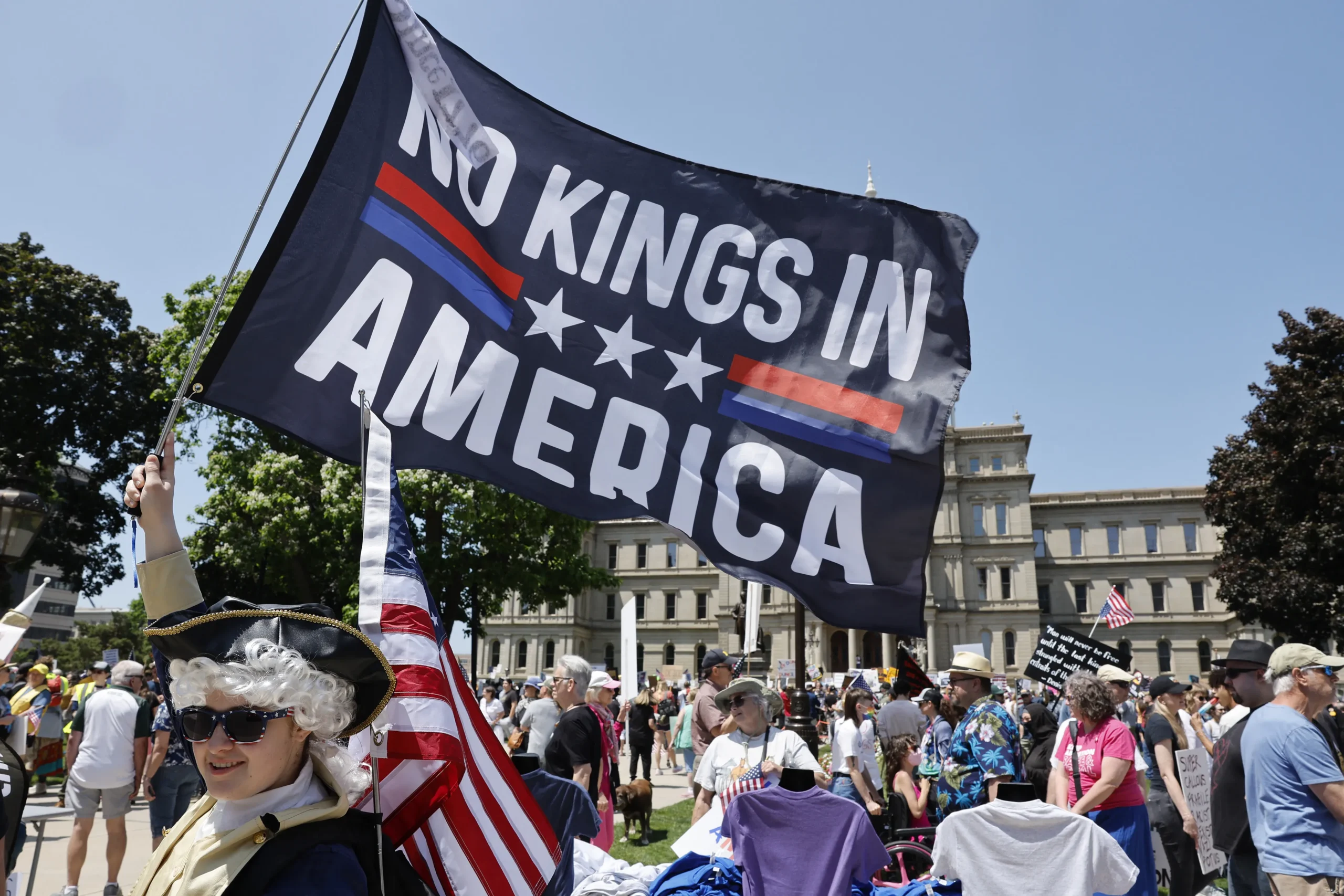Millions across America united in “No Kings” protests—bold, real, and global. Discover how citizens rose against authoritarian spectacle.
🔥1: When the Parade Met the People
It started as a dazzling tribute—tanks rolling down the National Mall, historic uniforms, roaring crowds, costing an estimated $25–45 million to commemorate the U.S. Army’s 250th anniversary on President Trump’s 79th birthday. But across the nation, an even bigger spectacle unfolded: millions took to the streets in the largest anti‑Trump event since his inauguration.
🌍 What Is “No Kings”?
“No Kings” is more than a viral slogan—it’s a nationwide movement. Organized by the grassroots 50501 movement (“50 protests, 50 states, 1 movement”), the rallies targeted authoritarian overreach: deploying ICE and the National Guard, undermining judicial orders, cracking down on dissent, and channeling military force at protesters.
What started as scattered local actions in early 2025 exploded into a massive national day of action. On June 14, over 2,000 protests erupted coast to coast, drawing anywhere from hundreds of thousands to millions, according to organizers .
🎭 Symbolism & Strategy: Puppet Thrones & Baby Blimps
The imagery was powerful—and theatrical. In D.C., protesters mocked the illusion of monarchy: an enormous puppet of Trump seated on a golden toilet, and across various cities, the viral Baby Trump balloon hovered over thousands shouting “No Kings!”.
In San Francisco, protesters formed human banners on Ocean Beach. In Chicago, they filled Daley Plaza chanting slogans like “People Over Billionaires” and crossing out crowns on signs. In one creative twist, Alaskans demanded, “The only king I want is king salmon”.
This was not just spectacle—it was strategic. The movement emphasized peaceful civil resistance, urging participants to de-escalate tensions and avoid confrontations.
🗺️ A Nation in Motion
Big Cities, Small Towns, Every Corner
- New York City: Up to 50,000 marched in Manhattan; dancers, activists, and everyday people staged a sea of signs and upside‑down American flags.
- Philadelphia: Between 50,000–80,000 chanted along the Parkway—not just opposition but a tribute to what citizens believe “America should be” .
- Los Angeles: What began peacefully escalated—tear gas, flash-bangs, police horses—and clashes with law enforcement .
- Small towns: From Big Rapids, MI to Boise, ID, hundreds rallied—no theatrics, just community members defending constitutional principles .
According to NPR, the coalition reported over 5 million participants across more than 2,000 events. France24 echoed organizers: “Millions took to the streets” opposing authoritarianism.
💥 Flashpoints & Tensions
No movement this size is immune to tensions:
- In Los Angeles, instigators allegedly provoked police—prompting tear gas and mounted units near City Hall.
- In Phoenix, a man brandished a handgun; in Virginia, a driver struck demonstrators—fortunately causing no serious injuries.
- In Minnesota, protests were canceled after a political assassination shook confidence: lawmakers were tragically targeted, prompting a “shelter in place” order .
Still, organizers stressed the peaceful essence: no property damage, no riots—just boisterous, joyful, and lawful expression .
🎙️ Voices from the Movement
“I just feel like we need to defend our democracy,” said Karen Van Trieste, a 61‑year‑old nurse in Philadelphia.
“Today what I saw was a boisterous, peaceful display of First Amendment rights,” said Ezra Levin, co‑founder of Indivisible in Philly.
A protester in Sacramento, Ali Schoenberger, admitted:
“It does feel like there’s a vendetta against people… So I feel like it’s important to … not expose them or even have it on my phone.”
Even celebrities joined the wave: Bernie Sanders marched in Vermont; Susan Sarandon and Mark Ruffalo were spotted in New York; Lynda Carter tweeted support.
⚖️ The Other Side of the Coin
Meanwhile, in Washington, D.C., the parade marched on. President Trump addressed troops from behind bulletproof glass, hailing the display as “long overdue”. His critics maintained that using military spectacle to celebrate personal power felt more like a monarchy than a republic .
A June 12 AP–NORC poll found 60 percent believe the parade was “not a good use of government money,” compared to 38 percent who approved.
🧭 Why It Matters Globally
While these were American protests, their message reverberates worldwide: a warning signal in times of rising authoritarianism. Some solidarity demos were held overseas under banners like “No Tyrants” . The global takeaway? Even massive military shows can be overshadowed when citizens choose democracy over dominance.
🔚 Closing Hook: The Fork in America’s Road
As night fell on June 14, both the parade and the protests had ended — but the cultural crosstalk had just begun. Was America celebrating unity or igniting fractures? Did the spectacle of tanks unify a nation—or prompt millions to demand a departure from authoritarian drift?
The answer lies ahead: in the next elections, in how the country heals, and in whether movements like “No Kings” transform momentary fervor into long-term democratic renewal.
One thing is certain: flags may fly, crowds may roar, but only time will tell which vision America embraces—kings or citizens.
David Beckham’s Knighthood: June 2025 Honor Explained

